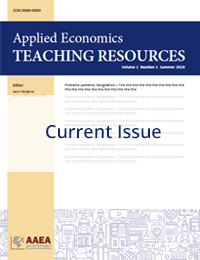Teaching and Educational Methods
Creating and Implementing Undergraduate Research Experiences: An Example for Analyzing the Size, Structure, and Performance of U.S. Food Manufacturing Industries
Yuliya V. Bolotova(a), Luke Juffer(a), Haylie Moore(a)
(a)Iowa State University
JEL Codes: JEL Codes: A2, L66, Q13
Keywords: Business consulting, Extension, food manufacturing, teaching, undergraduate research
First Published Online: March 8, 2025
View Full Article (PDF) | Request Teaching Notes/Supplemental Materials
Abstract
The article explains how to create and implement undergraduate research experiences using an example for analyzing the size, structure, and performance of U.S. food manufacturing industries. The research projects discussed in the article utilize publicly available data reported by the U.S. Census Bureau. The food manufacturing industries can be analyzed at the U.S., regional, and state level. In addition to gaining valuable data collection and analytical research skills, students acquire knowledge on economic and business aspects of food manufacturing industries that can be useful in their future careers. The research example presented in the article can be easily modified to fit the course, the level of undergraduate students, and the audiences.
References
Manufacturing Businesses in the US.” Journal of Food Distribution Research XL(1):1–7.
Asiseh, F., S. Devadoss, Y. Bolotova, J. Foltz, and R. Haggerty. 2010. “Factors Influencing Growth of Dairy Product Manufacturing in the United States.” International Food and Agribusiness Management Review 13:101–116.
Bolotova, Y. 2008. “The Economic Performance of Food Manufacturing Industries in Idaho.” Journal of Food Distribution Research XXXIX(1):18–24.
Bolotova, Y., and F. Asiseh. 2009. “Evaluating Economic Performance of Food Manufacturing Industries: An Analysis of the U.S. Pacific Northwest States.” Journal of Food Distribution Research 40:130–143.
Bolotova, Y. 2016. “Food Manufacturing Industry in South Carolina: An Analysis of the Size, Structure and Performance.” Journal of Food Distribution Research XLVII(1):12–17.
Capps, O., Jr., S.W. Fuller, and J.P. Nichols. 1988. “Assessing Opportunities in Food and Fiber Processing and Distribution.” American Journal of Agricultural Economics 70:462–468.
Christy, R.D., and J.M. Connor. 1989. “Economic Forces Influencing Value Added Industries: Implications for Southern Agriculture.” Southern Journal of Agricultural Economics:13–22.
Connor, J.M., R.T. Rogers, B.W. Marion, and W.F. Mueller. 1985. The Food Manufacturing Industries: Structure, Strategies, Performance and Policies. Lexington MA: Lexington Books, D.C. Heath and Company.
Connor, J.M. 1988. Food Processing: An Industrial Powerhouse in Transition. Lexington MA: Lexington Books, D.C. Heath and Company.
Henderson, J.R., and K.T. McNamara. 1997. “Community Attributes Influencing Local Food Processing Growth in the U.S. Corn Belt.” Canadian Journal of Agricultural Economics 45:235–250.
Henderson, J.R., and K.T. McNamara. 2000. “The Location of Food Manufacturing Plant Investments in Corn Belt Counties.” Journal of Agricultural and Resource Economics 25:680–697.
Huang, K. 2003. Food Manufacturing Productivity and Its Economic Implications. U.S. Department of Agriculture, Economic Research Service. Washington DC. Technical Bulletin No 1905.
Rogers, R. 2001. “Structural Change in U.S. Food Manufacturing, 1958–1997.” Agribusiness 17:3–32.
Salin, V., J.A. Atkins, and O. Salame. 2002. “Value Added in Food Manufacturing and Retailing: a Ratio Analysis of Major U.S. States.” Journal of Food Distribution Research:136–150.
U.S. Bureau of Labor Statistics. 2024. Producer Price Index. https://www.bls.gov/help/hlpforma.htm#OPLC
U.S. Census Bureau. 2021. Annual Survey of Manufactures. https://www.census.gov/data/tables/time-series/econ/asm/2018-2021-asm.html
U.S. Census Bureau. 2024a. https://www.census.gov/en.html
U.S. Census Bureau. 2024b. Annual Survey of Manufactures. https://www.census.gov/programs-surveys/asm.html
U.S. Census Bureau. 2024c. Glossary. https://www.census.gov/glossary/?group=ECON&term=Value+added+%28%241%2C000%29
U.S. Census Bureau. 2024d. Explore Census Data online database. https://data.census.gov/
U.S. Department of Agriculture, Economic Research Service. 2023. Manufacturing: Food and Beverage Manufacturing. Washington DC. https://www.ers.usda.gov/topics/food-markets-prices/processing-marketing/manufacturing/
U.S. Economic Census. 2002. 2002 Manufacturing (NAICS Sector 31-33). https://www.census.gov/library/publications/2002/econ/census/manufacturing-reports.html
U.S. Economic Census. 2004. 2002 Economic Census Manufacturing Industry Series: Fluid Milk Manufacturing: 2002. https://www2.census.gov/library/publications/economic-census/2002/manufacturing-reports/industry-series/ec0231i311511.pdf
U.S. Economic Census. 2024. https://www.census.gov/programs-surveys/economic-census.html
Articles in this issue
Dare to Experiment: The Synergistic Relationship Between Undergraduate Research and Experimental Economics
Carl Nelson-Poteet , Lusi Xie, Kent D. Messer, and Leah H. Palm-Forster
Engaging Undergraduate Students in Research: From Cross-Discipline Programs to Published Articles
Gal Hochman and Yanhong Jin
FIRE Sustainability Analytics: An Innovative Approach to Engaging Undergraduate Students in Economics Research
Thanich Ruangmas and Lars J. Olson
Creating and Implementing Undergraduate Research Experiences: An Example for Analyzing the Size, Structure, and Performance of U.S. Food Manufacturing Industries
Yuliya V. Bolotova, Luke Juffer, Haylie Moore
Undergraduate Applied Microeconomic Research with Demographic and Health Surveys
Seth R. Gitter, Chris M. Boyd, and Raissa Abbasi
Undergraduate Research in the Andes: Overcoming Barriers to Developing-Country Farm-Household Focused Analysis
Jeffrey Alwang, Victor Barrera, Darrell Bosch, Susan Chen, Jorge A. Delgado, et al.


